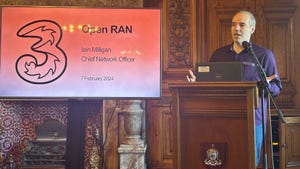Southeast Asia looks to satellite Internet to bridge digital divide
The Philippines' DICT taps satellite broadband to connect 438 remote areas as satellite communication emerges as the practical solution for Southeast Asian countries seeking to narrow their digital divide.
_16x9_.jpg?width=850&auto=webp&quality=95&format=jpg&disable=upscale)
The Philippine government has completed the installation of satellite broadband in 438 remote areas of the country as part of a National Broadband Plan that underpinned its free Wi-Fi program.
The latest project, which costs P206 million (US$3.6 million), involved setting up very small aperture terminals (VSAT) that can deliver Internet connectivity between 10 and 30 Mbit/s to about 400 people in one site at a given time. The project was completed in 30 days.
A VSAT is a two-way ground station that transmits and receives data from satellites. It is less than three meters tall and is capable of exchanging both narrow and broadband data with satellites in orbit in real-time.
The project, which is the largest VSAT installation and activation in the Philippines, is spearheaded by the country's Department of Information and Communications Technology (DICT) in collaboration with Internet service provider Stellarsat Solutions and its partner Kacific Broadband Satellites. The provinces covered by this satellite broadband project include Benguet, Kalinga, Ifugao, Ilocos Norte, Quezon and Pangasinan – most of them located in the northern part of Luzon Island.
''Connecting all the scattered islands of the Philippines remains a challenge, and the digital divide is still pronounced, especially in geographically isolated and disadvantaged areas (GIDA),'' Ivan John Uy, DICT secretary, said in a statement.
Through its National Broadband Plan, the DICT aims to provide connectivity to 65% of the population that lacks Internet access. Uy said they will add more sites to the program, as there are still thousands of GIDA sites that are not yet connected.
"We are aggressively expanding the coverage, as well as improving the quality. We're using all different means to do this – through fiber optic, through terrestrial lines, through wireless connectivity, submarine cables, as well as satellite connectivity," Uy told local news outlets.
For now, the Wi-Fi is free in many remote areas, but that may change if the DICT doesn't receive the support it needs to sustain the program.
Uy is hoping that the Philippine Congress will give DICT a higher budget for 2024 because that will determine the extent of their reach.
"We have to address the sustainability of this project. The government has only allowed them a limited amount of funds. Once we start deploying them and connecting them, I don’t think it can be given for free indefinitely," he said.
Practical choice for connectivity
According to Victor Xu, satellite communications research analyst at ABI Research, satellite Internet is making significant progress in narrowing the digital divide in Southeast Asia.
"Satellite Internet will become an increasingly practical choice for addressing connectivity challenges in the SE Asia region for several compelling reasons, such as the geographical diversity, rural and remote landscapes, recurring natural disasters, digital inclusion goals, and government initiatives," Xu said in a statement.
He pointed out that satellite Internet providers such as Kacific, Thaicom and Measat have been actively working to expand Internet access, particularly in remote and underserved areas.
"Their initiatives can potentially significantly improve Internet access and foster digital opportunities for people in Southeast Asia and beyond," Xu added.
In its latest report, ABI Research predicts that SatCom subscriptions in the subregion could exceed 1.8 million, generating over $2.1 billion in service revenue by 2028. These promising figures underscore the growing recognition of satellite Internet's value in addressing connectivity challenges across Southeast Asia.
"As the satellite Internet landscape continues to evolve, it is poised to play a pivotal role in fostering digital inclusion throughout Southeast Asia," said Xu.
Digitizing grassroots communities
Indeed, with its free Wi-Fi program, DICT not only provides access to essential online services in remote areas but also hopes to pave the way for community-based entrepreneurs to join the digital economy.
"With reliable and affordable broadband Internet, Filipinos in Northern Luzon province can access not only the Philippines but the entire world, capitalizing on the benefits of the digital era," said Uy. "By providing high-speed Internet connectivity to these GIDA sites, this project also equips the provinces' micro, small and medium enterprises with the tools to participate in the thriving e-commerce landscape."
The Philippines is not the only country in Southeast Asia to tap satellite-based connectivity to provide Internet access in areas not covered by traditional terrestrial networks.
In August, Malaysia's rural broadband service provider MEASAT teamed up with app-based parcel locker network system Parcel 365 to launch the Program Transformasi Usahawan (PTU) segment of the KampungDigital365.com, to help women entrepreneurs in rural villages tap into the digital economy.
The company also recently connected close to 600 schools in remote locations across the country through its high-speed satellite broadband service, in line with its commitment to deliver connectivity to underserved communities.
Neighboring Indonesia intends to link up remote corners of the archipelago to the Internet following the launch of its $540 million SATRIA-I satellite in June. The satellite has a throughput capacity of 150 gigabytes per second and will provide Internet access to 50,000 public service points across the country.
Roughly two-thirds of Indonesia's 280 million population already use the Internet, but connectivity is limited in far-flung, underdeveloped eastern islands of the country.
Seeing the business potential of linking remote areas of Southeast Asia, satellite firm OneWeb entered a multi-year deal with Thailand-based mu Space in March to deliver its connectivity services to Thailand, Laos, Cambodia, Vietnam and Malaysia.
Mu Space will distribute the satellite service to enterprises with applications in remote communities, land mobility, maritime opportunities and backhauling. It will be used for in-flight connectivity and remote monitoring of fires, floods and natural disasters, among other applications.
Read more about:
AsiaAbout the Author(s)
You May Also Like




.jpg?width=300&auto=webp&quality=80&disable=upscale)







